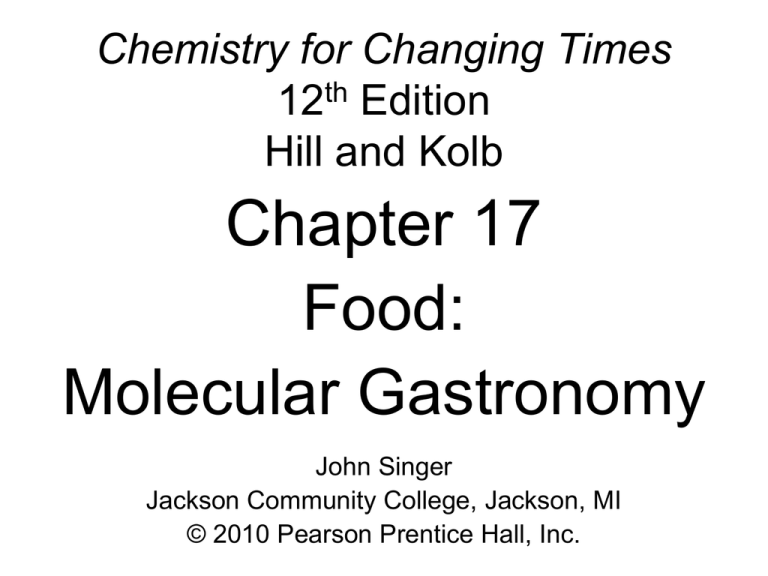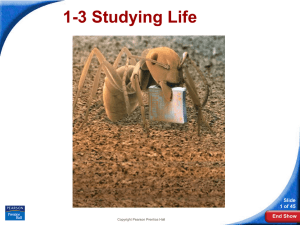
Chemistry for Changing Times
12th Edition
Hill and Kolb
Chapter 17
Food:
Molecular Gastronomy
John Singer
Jackson Community College, Jackson, MI
© 2010 Pearson Prentice Hall, Inc.
The Food We Eat
Foods are chemicals.
They include
carbohydrates, fats,
and proteins, along
with water, vitamins,
minerals, and fiber.
© 2010 Pearson Prentice Hall,
Inc.
17/2
Carbohydrates in the Diet
The monosaccharides glucose (dextrose) and
fructose, and the disaccharide sucrose are the
most common dietary sugars.
© 2010 Pearson Prentice Hall,
Inc.
17/3
Carbohydrates in the Diet
Digestion and Metabolism of Carbohydrates
Glucose and fructose are absorbed directly into
the bloodstream.
Sucrose is hydrolyzed into glucose and fructose.
Sucrose + H2O → Glucose + Fructose
© 2010 Pearson Prentice Hall,
Inc.
17/4
Carbohydrates in the Diet
Lactose, found in milk, is hydrolyzed to glucose
and galactose.
Lactose + H2O → Glucose + Galactose
Some people lack the enzyme necessary to
hydrolyze lactose. This is known as lactose
intolerance.
Galactose is converted to glucose during
metabolism. Some babies lack the enzyme
(galactosemia) necessary for this conversion and
require a synthetic formula for proper nutrition.
© 2010 Pearson Prentice Hall,
Inc.
17/5
Carbohydrates in the Diet
Complex Carbohydrates
Starch and cellulose starch are polymers of
glucose connected by alpha linkages; most
animals and humans possess the enzymes
necessary to hydrolyze starch to glucose that
can then serve as a source of energy.
Carbohydrates such as starch produce 4 kcal of
energy per gram.
Cellulose is a polymer of glucose connected by
beta linkages; most animals and humans lack
the enzymes necessary to hydrolyze cellulose,
and it serves as a source of roughage or dietary
fiber.
© 2010 Pearson Prentice Hall,
Inc.
17/6
Carbohydrates in the Diet
Glycogen is the means by which animals store
glucose. It is a highly branched polymer of alpha
glucose and is sometimes known as animal
starch. Excess glycogen is stored as fat.
Some bacteria found in the gut of termites and
digestive tract of grazing animals can hydrolyze
cellulose to glucose and these animals can use
cellulose as a source of food.
© 2010 Pearson Prentice Hall,
Inc.
17/7
Fats and Cholesterol
Fats are esters of fatty acids and glycerol. Some
fat is metabolized for energy and produces 9 kcal
of energy per gram. Some is used for cell
membranes.
© 2010 Pearson Prentice Hall,
Inc.
17/8
Fats and Cholesterol
Digestion and Metabolism of Fats
Fats are digested in the small intestine.
Enzymes called lipases hydrolyze
triacylglycerols into mono and diacyl glycerols,
fatty acids, and glycerol.
Fats are stored in the body in adipose tissue in
locations called fat deposits. Fat deposits are
located around major organs beneath the skin.
© 2010 Pearson Prentice Hall,
Inc.
17/9
Fats and Cholesterol
© 2010 Pearson Prentice Hall,
Inc.
17/10
Fats and Cholesterol
Dietary fats and cholesterol have been implicated in
arteriosclerosis and cardiovascular disease. Deposits
form on the inner walls of arteries called plaque.
Normal Artery
Hardened Artery
© 2010 Pearson Prentice
Hall, Inc.
17/11
Fats and Cholesterol
Plaques that clog arteries are rich in cholesterol.
Cholesterol is a fat-like steroid molecule that is common
to animal tissue. Cholesterol is carried in the blood by
lipoproteins. Lipoproteins are classified according to
their density. Very-low-density lipoproteins (VLDLs)
transport triglycerides. Low-density lipoproteins
(LDLs) carry cholesterol from the liver to the blood and
are responsible for the formation of plaques. LDLs are
the so-called “bad” cholesterol. High-density
lipoproteins (HDLs) carry the cholesterol to the liver
and are the so-called “good” cholesterol.
© 2010 Pearson Prentice Hall,
Inc.
17/12
Fats and Cholesterol
© 2010 Pearson Prentice Hall,
Inc.
17/13
Fats and Cholesterol
Diets high in saturated fats and trans fats have
been linked to high LDL levels in blood. It is
recommended that one limits the amount of
saturated fat and trans fat in the diet.
Trans fats are formed when unsaturated fats are
hydrogenated in order to make margarines or
more solid fats.
© 2010 Pearson Prentice Hall,
Inc.
17/14
Fats and Cholesterol
Saturated vs. Cis- vs. Trans-Unsaturated Fats
© 2010 Pearson Prentice Hall,
Inc.
17/15
Proteins
Proteins are digested into individual amino
acids. These amino acids are used to synthesize
proteins for growth and repair of tissue.
The body can synthesize all but nine amino
acids necessary for protein synthesis. These
nine amino acids are called essential amino
acids and include: isoleucine, lysine,
phenylalanine, tryptophan, leucine, methionine,
threonine, and valine.
© 2010 Pearson Prentice Hall,
Inc.
17/16
Proteins
Complete proteins contain all the essential
amino acids needed for growth and repair of
tissue. Lean meat, milk, fish, eggs, and cheese
contain complete proteins.
The human body requires about 0.8 g of protein
per kg of body weight. Protein deficiency can
lead to retarded growth and development,
discoloration of the skin and hair, and swollen
abdomen.
© 2010 Pearson Prentice Hall,
Inc.
17/17
Minerals: Inorganic Chemicals
and Life
Dietary minerals are the inorganic substances
necessary for life.
Bulk structural elements and macrominerals
make up more than 99% of all atoms in the
human body.
Trace elements and ultratrace elements make
up the rest.
© 2010 Pearson Prentice Hall,
Inc.
17/18
Minerals: Inorganic Chemicals
and Life
© 2010 Pearson Prentice Hall,
Inc.
17/19
Minerals: Inorganic Chemicals
and Life
Lack of dietary
minerals can have
serious consequences.
Lack of iodine in the
diet can lead to thyroid
goiters.
© 2010 Pearson Prentice Hall,
Inc.
17/20
Vitamins
Vitamins are organic compounds that are
essential in the diet. Vitamins do not include
proteins, fats, carbohydrates, and minerals.
Vitamins can be classified as either fat-soluble
or water-soluble.
© 2010 Pearson Prentice Hall,
Inc.
17/21
Vitamins
Fat-Soluble Vitamins
© 2010 Pearson Prentice Hall,
Inc.
17/22
Vitamins
Water-Soluble Vitamins
© 2010 Pearson Prentice Hall,
Inc.
17/23
Vitamins
© 2010 Pearson Prentice Hall,
Inc.
17/24
Vitamins
Vitamin deficiency can be
serious.
(a) Softened bones due to
deficiency of vitamin D.
(b) Pellagra due to
deficiency of niacin.
© 2010 Pearson Prentice Hall,
Inc.
17/25
Other Essentials: Fiber and
Water
Dietary Fiber
Fiber may be soluble or insoluble. Insoluble fiber
is mostly cellulose, whereas soluble fiber is
mostly gums and pectins. Fiber has a number of
benefits. It helps to maintain proper colon
function and may help to control blood sugar
and lower cholesterol levels.
© 2010 Pearson Prentice Hall,
Inc.
17/26
Other Essentials: Fiber and
Water
Water
Water is an essential part of our diet. Actually,
most of what we ingest is water. In addition, we
require 1-1.5 L of water daily.
© 2010 Pearson Prentice Hall,
Inc.
17/27
Starvation and Fasting
Starvation is the total deprivation of food. It
takes less than one day for the body to deplete
itself of glycogen stores. After the glycogen is
depleted, the body will then metabolize the fat
reserves. Fat metabolism leads to ketosis as
ketone bodies are released into the blood and
urine. This can lead to acidosis as the blood pH
drops. Body proteins will also be metabolized
and eventually muscle proteins will be
metabolized.
© 2010 Pearson Prentice Hall,
Inc.
17/28
Starvation and Fasting
Ketone Bodies
© 2010 Pearson Prentice Hall,
Inc.
17/29
Starvation and Fasting
Malnutrition can also
occur due to eating too
much processed food.
Processing of food
removes much of the
nutritional value and fiber.
It is ironic that people in
developed nations
experience obesity and
poor nutrition while living in
a land of food abundance.
© 2010 Pearson Prentice Hall,
Inc.
17/30
Food Additives
Food additives are substances other than basic
food stuffs added to food as a result of
production, processing, packaging, or storage.
Sugar, salt, corn syrup, citric acid, baking soda,
vegetable colors, mustard, and pepper make up
more than 98% of all additives by weight.
© 2010 Pearson Prentice Hall,
Inc.
17/31
Food Additives
Additives that Improve Nutrition
KI: Added to salt to prevent goiter.
Vitamin B1: Added to polished rice.
Vitamin C: Added to fruit juice and other
beverages.
Vitamin D: Added to milk to prevent
rickets.
Vitamin A: Added to margarine to match
nutritional value of butter.
© 2010 Pearson Prentice Hall,
Inc.
17/32
Food Additives
Flavoring Agents
© 2010 Pearson Prentice Hall,
Inc.
17/33
Food Additives
Artificial Sweeteners
© 2010 Pearson Prentice Hall,
Inc.
17/34
Food Additives
Artificial Sweeteners
© 2010 Pearson Prentice Hall,
Inc.
17/35
Food Additives
Flavor Enhancers
A popular flavor enhancer is monosodium
glutamate (MSG).
Excess MSG can be harmful. It has been shown
to cause birth defects if eaten in large amounts
by pregnant women.
© 2010 Pearson Prentice Hall,
Inc.
17/36
Food Additives
Spoilage inhibitors:
Antimicrobials prevent
spoilage from molds,
yeasts, or bacteria.
Propionic acid, sorbic acid,
benzoic acid, and their salts
can be used.
© 2010 Pearson Prentice Hall,
Inc.
17/37
Food Additives
Spoilage Inhibitors
Sodium nitrate (NaNO2) is used to cure meats
and gives the pink color to ham, hot dogs,
bacon, and bologna. However, stomach acid
converts the nitrite ion to nitrous acid, which can
then react with amines to form nitrosoamines,
which are known carcinogens.
© 2010 Pearson Prentice Hall,
Inc.
17/38
Food Additives
Antioxidants: BHA and BHT
Foods that contain fats can turn rancid due to
the formation of free radicals. Antioxidants react
with free radicals, preventing their chain reaction
formation. Antioxidants include butylated
hydroxytoluene (BHT), butylated hydroxyanisole
(BHA), tert-butylhydroquinone, and propyl
gallate.
© 2010 Pearson Prentice Hall,
Inc.
17/39
Food Additives
Antioxidants
© 2010 Pearson Prentice Hall,
Inc.
17/40
Food Additives
Food Colors
© 2010 Pearson Prentice Hall,
Inc.
17/41
Food Additives
Food Colors
Some food colors such as FD & C Orange No. 1
have been banned by the FDA. Others have
been found to be carcinogens. Even so, they
present little risk since they are used in such
small amounts.
© 2010 Pearson Prentice Hall,
Inc.
17/42
Food Additives
Nanoscience in Foods
Nanoscience and nanotechnology involve the
production and use of materials at the
nanometer scale.
© 2010 Pearson Prentice Hall,
Inc.
17/43
Food Additives
Nanofoods are being explored which contain
nanocapsules that can change color, flavor, and
texture of foods.
© 2010 Pearson Prentice Hall,
Inc.
17/44
Food Additives
Nanopackaging is being developed to improve
the shelf life of food by employing nanoparticles
in films that block out or remove harmful gases,
such as carbon dioxide or oxygen, that spoil
food.
© 2010 Pearson Prentice Hall,
Inc.
17/45
Food Additives
Nanosecurity devices are being developed for
both pathogen and contaminant detection.
© 2010 Pearson Prentice Hall,
Inc.
17/46
Poisons in Our Food
Carcinogens
Foods contain both natural and added
carcinogens. Scientists estimate that we
consume natural carcinogens at 10,000 times
the rate of synthetic carcinogens.
© 2010 Pearson Prentice Hall,
Inc.
17/47
Poisons in Our Food
Incidental Additives
Incidental additives get into food accidentally
during production, processing, packaging, or
storage. About 10,000 incidental additives end
up in our food. Some have been causes of
concern, including Alar (its breakdown product is
dimethylhydrazine, a suspected carcinogen),
PCBs, PBBs, antibiotics, DES, etc.
© 2010 Pearson Prentice Hall,
Inc.
17/48
A World without Food Additives
Food additives are likely a necessary part of a
modern society. Each year in the U.S., there are
76 million illnesses, including 5,000 deaths due
to bacteria, viruses, and parasites in food. Few,
if any, deaths are associated with the use of
intentional food additives.
© 2010 Pearson Prentice Hall,
Inc.
17/49






